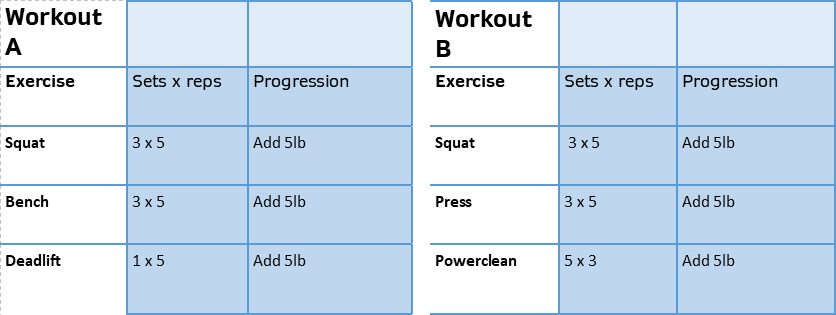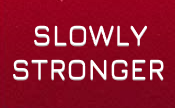7/10 – Solid starting program, could be better.
Introduction
Starting Strength’s novice linear progression program, developed by Mark Rippetoe, gained huge amounts of fame back in 2010-2017. It was almost universally recommended on all forums that involved some degree of weight training. We owe Starting Strength a thanks. Programming and strength training in the early 2000s was ineffective, and at times… rather unusual. People were following the same workouts or routines without ever increasing the weight and without ever touching movements like squats or deadlifts. Starting Strength’s fame contributed massively to changing this, advocating simplicity by focusing on a few key lifts and just adding weight each workout. This overemphasis on simplicity is, perhaps, a drawback of Starting Strength, but it was desperately needed 10-15 years ago when so many programs were ridiculously complex, illogical and at times weird.
Article Video
The Program

You train three times per week, alternating workout A and B. For example:
Monday – Workout A
Wednesday – Workout B
Friday – Workout A
Monday – Workout B
Wednesday – Workout A
Friday – Workout B
You add 5lb to the bar each workout you do. There is a “Phase 1”, “Phase 2” and “Phase 3”, with minor differences between them (check out StartingStrength.com for the phases).
In Phase 1, you should be deadlifting every day, and this usually lasts just a couple of weeks. You’d then swap to Phase 2 (above), and then phase 3).
The Good
The program is simple. The simplicity of Starting Strength means a new lifter can easily pick it up and get started in the gym. When I see some novice programs, I often wonder how someone who has never set foot in a gym is meant to even understand these complex novice programs. I recall writing a strength program for my partner: she had no idea what a bench press or deadlift were, let alone how to perform them correctly. She didn’t understand linear progression (or progressive overload), or about sets and reps. Adding in something like RPE for her would have been incredibly off-putting. She is a very intelligent woman, but the amount she had to learn for something she was already “on the fence” about was already off-putting, without having to add in RPE. She wanted something she could just go to the gym, bang-out quickly, and come home. More complexity may yield better results if the lifter can follow the complexity easily enough, but the complexity should not come at the expense of adherence. This is the beauty of Starting Strength: it is simple and easy to understand. The barrier to entry is literally knowing how to perform the movements, what sets and reps are, and how long to rest.
It has a strong focus on the key lifts: Squat, Bench, Press and Deadlift. Most exercises are either: variations of these four lifts; simple machine-based exercises; or easy to master isolation or bodyweight exercises. If a lifter masters these four lifts in their novice phase, then they can very easily learn new movements. It sets them up well for future programs regardless of what they are.
The program emphasises progression. The entire premise of it is that you perform big compound movements, moving a the most weight through the most effective range of motion, and add weight to the bar each session. The biggest improvements for novice lifters is skill and neurological adaptations. Squatting 3x per week improves your skill and neurological adaptations pretty efficiently, meaning novice lifters can easily progress workout-workout when they first start out. This is the entire reason the Starting Strength program was so effective back in 2010, back then it was very common to see people do the same weight week-in, week-out. Starting Strength forces progression, and fast progression.
Finally, a controversial take, but I like the inclusion of the powerclean. Just not for the reasons Starting Strength like it for. Starting Strength recommends it as a movement to help drive the deadlift up, as due to its fast and explosive nature it allows the lifter to exert more force in a pulling motion, which can help increase pulling strength. Unfortunately, there is little evidence to support this view. However, I like it because teaches novices the skill of exerting force in an explosive manner, which can set them up well for future programs or sports that require explosive movements. It also teaches the novice lifter how to actually perform an easy variation of an Olympic lift. This sets him or her up for future programs and exposes them to different barbell sports. How can a novice lifter know whether they want to do Olympic lifting without ever doing an Olympic lift? Maybe the lifter would love crossfit or want to dip their toe in it in the future? Maybe they just enjoy movements like this? The inclusion of the powerclean therefore enables a novice lifter to move on to a wider variety of programs and sports without such a steep learning curve. They would still have to learn the full clean and the full snatch, but these are easily learnt if you can already perform the powerclean. However, the powerclean can, and usually is, substituted out for the Barbell Row. People dislike the inclusion of the powerclean and simply don’t do it – this is the reason I don’t include it in my own recommended Novice Strength Program. The substitution for a row is completely fine.
The Bad
The upper-body volume is lacking. The well-known meme for starting strength is that it activates ‘t-rex’ mode. There are 9 sets for the squat per week. Yet only 4.5 sets (9 sets across a fortnight) for the bench press. Lifters stall quite early on with the bench press and overhead press, and this is almost certainly due to a lack of volume. There is enough volume for a rank novice to progress, and even after the initial few weeks some minimal but consistent gains can still be obtained. However, it is not nearly enough volume to obtain optimal muscle and strength gains. Ten sets per week is considered the ideal minimum for novices, but even then for upper-body volume this can increase to 15+ sets. I have first hand experience with this. I started Starting Strength way back in 2014ish, I was 145lb and 6 foot. I added a lot of muscle quickly, but almost all to my lower body. If I was to run it again, the easy way to fix this is to do just do some light accessory benching on overhead press days.
Deadlift volume is lacking. Starting Strength has the notion that deadlifts are very taxing and stressful on the body. Whilst I think the notion that they are more stress-inducing than other lifts and are harder to recover from, the amount of stress that Starting Strength claims they cause is largely overblown. However, Phase 2 (above), has you lifting 1.5 sets per week. Phase 3 has you lifting one set per week. This is incredibly low volume. Frankly, it is ridiculously low volume. Deadlifts may well be more stress-inducing than the other lifts, but you can very easily recover from more than one set per week. You can also adapt to higher volumes of the deadlift just like you can any other lift. The poor deadlift volume also means that when you need to increase the volume to actually make progress as an intermediate lifter then you are in for a shock! The easy fix is simply adding a few back-off sets to the deadlift.
Just like with the upper-body and deadlift volume, there can be a lack of upper-back work (if Powercleans are used instead of barbell rows). In Phase 3 you will add Chin-ups, but until then, you will only get back work through 1.5 sets of deadlifts per week (or 3 sets per week during Phase 1). The simple solution is to add a few sets of chin-ups on the pressing days during Phase 2, or to substitute Powercleans for Rows.
The rep-ranges are very limited. Look, I love sets of 5. I did Starting Strength when I first hit the gym, and sets of 5 were my favourite thing in the world after a period of Starting Strength. Until I tried to do a set of 8 RDLs and it felt like it nearly killed me. There is a lot of literature recommending more varied training for novice lifters, and likewise, there is a lot of literature advocating the use of sets of 8+ reps for muscular hypertrophy. If a novice has never done more than sets of 5, then they will not be well prepared for post-novice programs which have sets of 8+.
The progression scheme can be incredibly dogmatic. You must add 5lb each workout (or 2.5lb for the overhead press). If you don’t then the assumption is you are doing something wrong. If you are doing everything right, you are usually expected to deload, and then build back up again over the next few weeks, expecting your body to magically be able to continue building strength. The reality is, once you stall you have probably reached the end of the rapid strength gains coming from the initial skill and neurological adaptations. The adaptations from there will start slowing down, and the benefits of deloading and building back up is questionable when compared to moving on to more advanced programming.
Is it worth trying?
There are more bad points than good points. However, despite this, the program can yield some very good results for new lifters, and would not be a bad starting point at all. I started on Starting Strength, and it definitely set me up for future lifting. Are there better novice programs? Of course! (shameless plug to my novice strength program). But a year down the line you won’t regret doing Starting Strength. The difference between Starting Strength and other novice programs which may yield better results is not too significant at all. It may not be the best program to perform, but it is completely fine and definitely worth a shot.
With all this said, I need to caution you: Starting Strength is a novice program. It should usually be run for 8-12 weeks (sometimes up to 16 or so weeks on rare occasions). No program will get you ripped, strong and jacked after just a few months. Likewise, if you are still doing starting strength after 9 months, you are probably doing something wrong, as it is just not feasible for this long given you are meant to add 5lb every workout. Follow the novice program, with the progression scheme, and move on once it stops working.
Finally, if you do follow Starting Strength, I’d suggest adding 3 sets of 8-10 reps of additional bench work to the benching days, this could be dips, dumbbell bench, close-grip bench, pause bench, or just standard benching. I’d also suggest adding 2 back-off sets to the deadlift days once you reach Phase 2, and 3 sets of chin-ups to failure to the pressing days. You may want to add this additional volume slowly, over the course of 2-3 weeks. I would personally just recommending avoiding Phase 3, and if you stall move on to more advanced programs rather than trying to grind out each rep in near-death experiences each workout.
